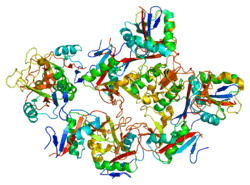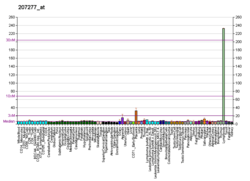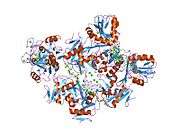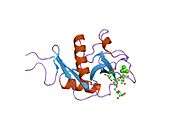DC-SIGN
DC-SIGN (Dendritic Cell-Specific Intercellular adhesion molecule-3-Grabbing Non-integrin) also known as CD209 (Cluster of Differentiation 209) is a protein which in humans is encoded by the CD209 gene.[5]
DC-SIGN is a C-type lectin receptor present on the surface of both macrophages and dendritic cells. DC-SIGN on macrophages recognises and binds to mannose type carbohydrates, a class of pathogen associated molecular patterns PAMPs commonly found on viruses, bacteria and fungi. This binding interaction activates phagocytosis.[6] On myeloid and pre-plasmacytoid dendritic cells DC-SIGN mediates dendritic cell rolling interactions with blood endothelium and activation of CD4+ T cells, as well as recognition of pathogen haptens.
Function
DC-SIGN is a C-type lectin and has a high affinity for the ICAM3 molecule.[7] It binds various microorganisms by recognizing high-mannose-containing glycoproteins on their envelopes and especially functions as receptor for several viruses such as HIV and Hepatitis C.[8][9][10] Binding to DC-SIGN can promote HIV and Hepatitis C virus to infect T-cell from dendritic cells.[9][10] Thus binding to DC-SIGN is an essential process for HIV infection.[11]
Besides functioning as an adhesion molecule, recent study has also shown that DC-SIGN can initiate innate immunity by modulating toll-like receptors,[12] though the detailed mechanism is not yet known. DC-SIGN together with other C-type lectins is involved in recognition of tumors by dendritic cells. DC-SIGN is also a potential engineering target for dendritic cell based cancer vaccine.[13]
Role in HIV infection
This molecule is involved in the initial stages of the human immunodeficiency virus infection, as the HIV gp120 molecule causes co-internalization of the DC-SIGN molecule and HIV virus particle (virion). The dendritic cell then migrates to the cognate lymphoid organ, whereupon recycling of the DC-SIGN/HIV virion complex to the cell periphery facilitates HIV infection of CD4+ T cells by interaction between DC-SIGN and ICAM-3.[14]
Gene family
DC-SIGN/CD209 is an animal "C-lectin", a large and diverse family of proteins found in both prokaryotes and eukaryotes most of which are functional lectins, meaning they bind carbohydrate ligands, and whose ligand-binding affinity requires calcium (hence "C-lectin"). Among the animal C-lectins, a subfamily known as the ASGR (asialoglycoprotein receptors) group contains several sub-sub-families, many of which are important to innate immunity.
A cluster of genes in both humans and mice contains three related members of the "DC Receptor" class, so named because of their homology to DC-SIGN. Of these, CD23 is, however, not expressed on dendritic cells but is a characteristic surface molecule of B lymphocytes, and LSectin (CLEC4G) is expressed on the sinusoidal endothelium of the liver. The third gene group consists of multiple paralogues of CD209. Thus, both primates and mice have multiple paralogues of CD209 more closely related to each other within the species than to their orthologous counterparts in the other species. Higher primates have at least three DC-SIGN genes, DC-SIGN, DC-SIGNL1 and DC-SIGNL2, although not all three are present in every species; DC-SIGNL2 has not been detected in humans. Eight paralogous of DC-SIGN have been reported in the laboratory mouse strain C57BL/6; these go by the names DC-SIGN, DC-SIGNR2...DC-SIGNR8. DC-SIGNR6 is a pseudogene. The genes labeled "DC-SIGN" in the human and mouse are thus not unique orthologues, although they resemble each other functionally and by being expressed on dendritic cells. Other members of the mouse CD209 gene group are differentially expressed on different cell types. For example, DC-SIGNR1 is expressed largely on macrophages in the marginal zones of the spleen and in the medulla of lymph nodes.[15]
References
- 1 2 3 GRCh38: Ensembl release 89: ENSG00000090659 - Ensembl, May 2017
- 1 2 3 GRCm38: Ensembl release 89: ENSMUSG00000040197 - Ensembl, May 2017
- ↑ "Human PubMed Reference:".
- ↑ "Mouse PubMed Reference:".
- ↑ Curtis BM, Scharnowske S, Watson AJ (September 1992). "Sequence and expression of a membrane-associated C-type lectin that exhibits CD4-independent binding of human immunodeficiency virus envelope glycoprotein gp120". Proc. Natl. Acad. Sci. U.S.A. 89 (17): 8356–60. doi:10.1073/pnas.89.17.8356. PMC 49917. PMID 1518869.
- ↑ McGreal E, Miller J, Gordon S (2005). "Ligand recognition by antigen-presenting cell C-type lectin receptors". Curr Opin Immunol. 17 (1): 18–24. doi:10.1016/j.coi.2004.12.001. PMID 15653305.
- ↑ Khoo US, Chan KY, Chan VS, Lin CL (August 2008). "DC-SIGN and L-SIGN: the SIGNs for infection". J. Mol. Med. 86 (8): 861–74. doi:10.1007/s00109-008-0350-2. PMID 18458800.
- ↑ Lozach PY, Burleigh L, Staropoli I, Amara A (2007). "The C type lectins DC-SIGN and L-SIGN: receptors for viral glycoproteins". Methods Mol. Biol. Methods in Molecular Biology. 379: 51–68. doi:10.1007/978-1-59745-393-6_4. ISBN 978-1-58829-590-3. PMID 17502670.
- 1 2 Lozach PY, Amara A, Bartosch B, Virelizier JL, Arenzana-Seisdedos F, Cosset FL, Altmeyer R (July 2004). "C-type lectins L-SIGN and DC-SIGN capture and transmit infectious hepatitis C virus pseudotype particles". J. Biol. Chem. 279 (31): 32035–45. doi:10.1074/jbc.M402296200. PMID 15166245.
- 1 2 Geijtenbeek TB, Kwon DS, Torensma R, van Vliet SJ, van Duijnhoven GC, Middle J, Cornelissen IL, Nottet HS, KewalRamani VN, Littman DR, Figdor CG, van Kooyk Y (March 2000). "DC-SIGN, a dendritic cell-specific HIV-1-binding protein that enhances trans-infection of T cells". Cell. 100 (5): 587–97. doi:10.1016/S0092-8674(00)80694-7. PMID 10721995.
- ↑ Wu L, Martin TD, Vazeux R, Unutmaz D, KewalRamani VN (June 2002). "Functional Evaluation of DC-SIGN Monoclonal Antibodies Reveals DC-SIGN Interactions with ICAM-3 Do Not Promote Human Immunodeficiency Virus Type 1 Transmission". J. Virol. 76 (12): 5905–14. doi:10.1128/JVI.76.12.5905-5914.2002. PMC 136240. PMID 12021323.
- ↑ den Dunnen J, Gringhuis SI, Geijtenbeek TB (November 2008). "Innate signaling by the C-type lectin DC-SIGN dictates immune responses". Cancer Immunol. Immunother. 58 (7): 1149–57. doi:10.1007/s00262-008-0615-1. PMID 18998127.
- ↑ Aarnoudse CA, Garcia Vallejo JJ, Saeland E, van Kooyk Y (February 2006). "Recognition of tumor glycans by antigen-presenting cells". Curr. Opin. Immunol. 18 (1): 105–11. doi:10.1016/j.coi.2005.11.001. PMID 16303292.
- ↑ van den Berg LM, Geijtenbeek TB (2013). "Antiviral immune responses by human langerhans cells and dendritic cells in HIV-1 infection". Advances in Experimental Medicine and Biology. 762: 45–70. doi:10.1007/978-1-4614-4433-6_2. PMID 22975871.
- ↑ Ortiz M, Kaessmann H, Zhang K, Bashirova A, Carrington M, Quintana-Murci L, Telenti A (September 2008). "The evolutionary history of the CD209 (DC-SIGN) family in humans and non-human primates". Genes Immun. 9 (6): 483–92. doi:10.1038/gene.2008.40. PMC 2701223. PMID 18528403.
Further reading
- Geijtenbeek TB, Engering A, Van Kooyk Y (2002). "DC-SIGN, a C-type lectin on dendritic cells that unveils many aspects of dendritic cell biology". J. Leukoc. Biol. 71 (6): 921–31. PMID 12050176.
- Baribaud F, Doms RW, Pöhlmann S (2006). "The role of DC-SIGN and DC-SIGNR in HIV and Ebola virus infection: can potential therapeutics block virus transmission and dissemination?". Expert Opin. Ther. Targets. 6 (4): 423–31. doi:10.1517/14728222.6.4.423. PMID 12223058.
- Bénichou S, Benmerah A (2003). "[The HIV nef and the Kaposi-sarcoma-associated virus K3/K5 proteins: "parasites"of the endocytosis pathway]". Med Sci (Paris). 19 (1): 100–6. doi:10.1051/medsci/2003191100. PMID 12836198.
- van Kooyk Y, Geijtenbeek TB (2003). "DC-SIGN: escape mechanism for pathogens". Nat. Rev. Immunol. 3 (9): 697–709. doi:10.1038/nri1182. PMID 12949494.
- Turville S, Wilkinson J, Cameron P, et al. (2004). "The role of dendritic cell C-type lectin receptors in HIV pathogenesis". J. Leukoc. Biol. 74 (5): 710–8. doi:10.1189/jlb.0503208. PMID 12960229.
- Cambi A, Figdor CG (2004). "Dual function of C-type lectin-like receptors in the immune system". Curr. Opin. Cell Biol. 15 (5): 539–46. doi:10.1016/j.ceb.2003.08.004. PMID 14519388.
- Joseph AM, Kumar M, Mitra D (2005). "Nef: "necessary and enforcing factor" in HIV infection". Curr. HIV Res. 3 (1): 87–94. doi:10.2174/1570162052773013. PMID 15638726.
- Stove V, Verhasselt B (2006). "Modelling thymic HIV-1 Nef effects". Curr. HIV Res. 4 (1): 57–64. doi:10.2174/157016206775197583. PMID 16454711.
- Ortiz M, Kaessmann H, Zhang K, Bashirova A, Carrington M, Quintana-Murci L, Telenti A (2008). "The evolutionary history of the CD209 (DC-SIGN) family in humans and non-human primates". Genes Immun. 9 (6): 483–492. doi:10.1038/gene.2008.40. PMC 2701223. PMID 18528403.
- Becer CR, Gibson MI, Geng J, Ilyas R, Wallis R, Mitchell D, Haddleton DM (2010). "High-Affinity Glycopolymer Binding to Human DC-SIGN and Disruption of DC-SIGN Interactions with HIV Envelope Glycoprotein". J. Am. Chem. Soc. 132 (43): 15130–15132. doi:10.1021/ja1056714. PMC 3091610. PMID 20932025.
External links
- DC-SIGN at the US National Library of Medicine Medical Subject Headings (MeSH)
This article incorporates text from the United States National Library of Medicine, which is in the public domain.











